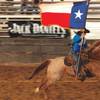

Ah, rodeo time in Texas.
If you grew up in Texas, there’s not much chance that you haven’t been to a rodeo, after all, it is the State Sport.
There’s something that draws people from all walks of life; the thrill of watching ‘real’ cowboys and cowgirls riding powerful horses through obstacles and challenges is something that even the most urban dweller can appreciate.
The cowboy lifestyle has forever been romanticized, and since most folks will never be able to experience the day to day life they lead, the rodeo is the next best thing.
Rodeos are not a new phenomenon, however. The beginnings of the sport date back to the sixteenth-century, when conquistadors participated in contests of cattle wrangling and bullfighting.
Originally, Spanish ranchers and their Mexican ranch hands were the first to participate in the practice, and slowly, they shared it with their neighbors to the north.
Then, the skills used were required for cattle ranching, and the earliest rodeos were events with cowboys and vaqueros testing their skills out against one another.
They were informal affairs until 1929, when the first rodeo associations were formed and standardizations were implemented. The sport continued to evolve.
In the 1970s, the game was forever changed. It became more popular than ever, attracting more ‘urban’ cowboys instead of just the ones who grew up on ranches. Purses (prizes for winning the events) got larger, as did arenas. It was no longer necessarily the down and dirty sport it had once been.
Fast forward to today, and rodeos can be big business.
All of the major cities in Texas host one each year, drawing thousands in to watch the captivating performances of roping, barrel-racing, and the most popular – bull riding.
People from all walks of life file into the stands to see the men and women who have chosen the rodeo as their profession try to beat the timer and come out with the most cash.
Whether it’s team toping, breakaway roping, or calf roping, crowds cheer as the riders attempt to rope a steer who clearly does not want to be caught.
Working cowboys often had to rope calves or cows for routine tasks such as branding or administering treatment.
Roping requires that the rider and horse work together to not only catch the calf, but to then hold the calf in its bindings for a specified amount of time.
While they make it look easy, the skill and athleticism involved in the process is quite astounding. Attempting to rope a stationary practice steer is nearly impossible for the layman. Add to it trying to rope a calf on the lam while you’re racing on atop a half-ton animal. It becomes quite an amazing feat of balance, coordination and timing.
Steer wrestling is another one of those events where, as you’re watching, you find yourself holding your breath, waiting for the cowboy to leap from his horse to flip the steer by the horns onto its back.
This timed event is also known as bulldogging, and was invented by Texas native Bill Pickett.
Pickett was born near Liberty Hill in 1870 and grew up in Taylor. The second of thirteen children, Pickett left school in the fifth grade and went to work as a ranch hand.
At that time, bulldogs were used to catch stray steer. Pickett decided he could do that, too, and began practicing the stunt, riding his horse hard, leaping from his saddle and wrestling the steer to the ground. He would bite the cow on the lip and fall backward to bring it down.
That particular method fell out of fashion, no doubt to the relief to the men who now practice the sport.
As for Pickett, he continued developing tricks and stunts and became rather famous at local county fairs. He and his four brothers established The Pickett Brothers Bronco Busters and Rough Riders Association, and they traveled all over wowing crowds.
After the turn of the century, he joined the 101 Ranch Wild West Show, which featured Buffalo Bill and Will Rogers, among others.
He died in 1932 at the age of 61, after being kicked in the head by a bronco.
While the roping events can be done by both women and men, barrel racing is exclusively a woman’s sport.
A cowgirl comes shooting into the arena astride a horse bred for speed and agility and in an attempt to get the lowest time, guides the horse around three barrels in a clover pattern, without knocking any over.
As they round the barrels, they seem to defy gravity as they, and their horses become almost parallel to the ground. You can see how fast they are going by the rocking of the barrels from the draft they create as they rush by.
Riders typically start young, practicing in your rodeos and maneuvering around poles and various barrel set ups.
The events that draw the biggest crowds are gasp-inducing events – Bronco and Bull Riding.
Both events call for a rider to climb onto a fierce animal that absolutely does not want to be ridden, and then attempt to stay on for at least eight seconds, despite the violent thrashing and jumping employed by the animal to remove said rider from its back.
Bronc riding was developed based on the skills and techniques used to break horses. There are two versions – bareback and saddle bronc riding. Neither is easy, and both are dangerous.
It is a myth that the broncos used in the competition are wild; they are usually geldings, a castrated male horse. They are bred specifically to be used in rodeos; tamed to the extent that they can be safely handled and receive medical care, they are raised ‘semi-wild’ on the open range.
Bull riders are probably the most popular, given that they attempt to harness an animal that can weigh a ton without having it crush or impale them.
There is not another event in rodeos that come close to the level of danger involved in bull riding. Over the course of the career of a bull rider, they will break bones and be injured many times over.
The goal, of course, is to stay on the bull for the magic eight seconds before dismounting. The second task is to get away from the angry animal before it either tramples you, or catches you with its horns.
Luckily for the rider, there is a group that is perhaps the bravest at the rodeo – the rodeo clowns. These guys distract the bull – basically asking and prompting the bull to come after them, in order for the rider the opportunity to exit the arena.
They put themselves in the path of these behemoths, risking their lives to save their fellow cowboys. They may be dressed silly, but without them, tragedy would certainly meet the fallen cowboy.
All of these competitions come together, presenting a hugely entertaining, highly competitive, and most exciting event.
Local rodeos are a lot of times kicked off with a parade and some coincide with stock shows for kids to show their livestock that they’ve raised.
Usually, a rodeo will last several days, with the ones held in the metro areas lasting a couple of weeks.
The larger shows include famous entertainers headlining each night after the bull riding event.
Local rodeos can be any combination of events, sometimes hosting only roping, or having different nights for each one, but always ending with the most favorite, bull riding.
Wherever you are in the Texas Hill Country, you’re probably not far from a rodeo. And now, with the increased number of rodeo arena popping up, you can find roping every weekend.
Check out the rodeo next time it comes to town. Even if you’ve never two-stepped, you’ll be entertained.



